The Impact of Reward Systems on Talent Attraction and Retention
VerifiedAdded on 2021/02/20
|11
|3648
|81
Report
AI Summary
This report investigates the impact of reward systems on talent attraction and retention, focusing on Visy Industries. The research explores the problem statement of high employee turnover due to inadequate reward systems, aiming to understand the importance of long-term company success. The report outlines the research aim, objectives, and questions, followed by a justification of the project's potential outcomes. It delves into the conceptual framework, including design thinking and hypothesis development. The methodology section details both qualitative and quantitative research methods, including data collection techniques like sampling. The report also includes a project budget, a Gantt chart, and references, providing a comprehensive analysis of the topic and potential strategies to improve employee attractiveness and retention within Visy Industries.
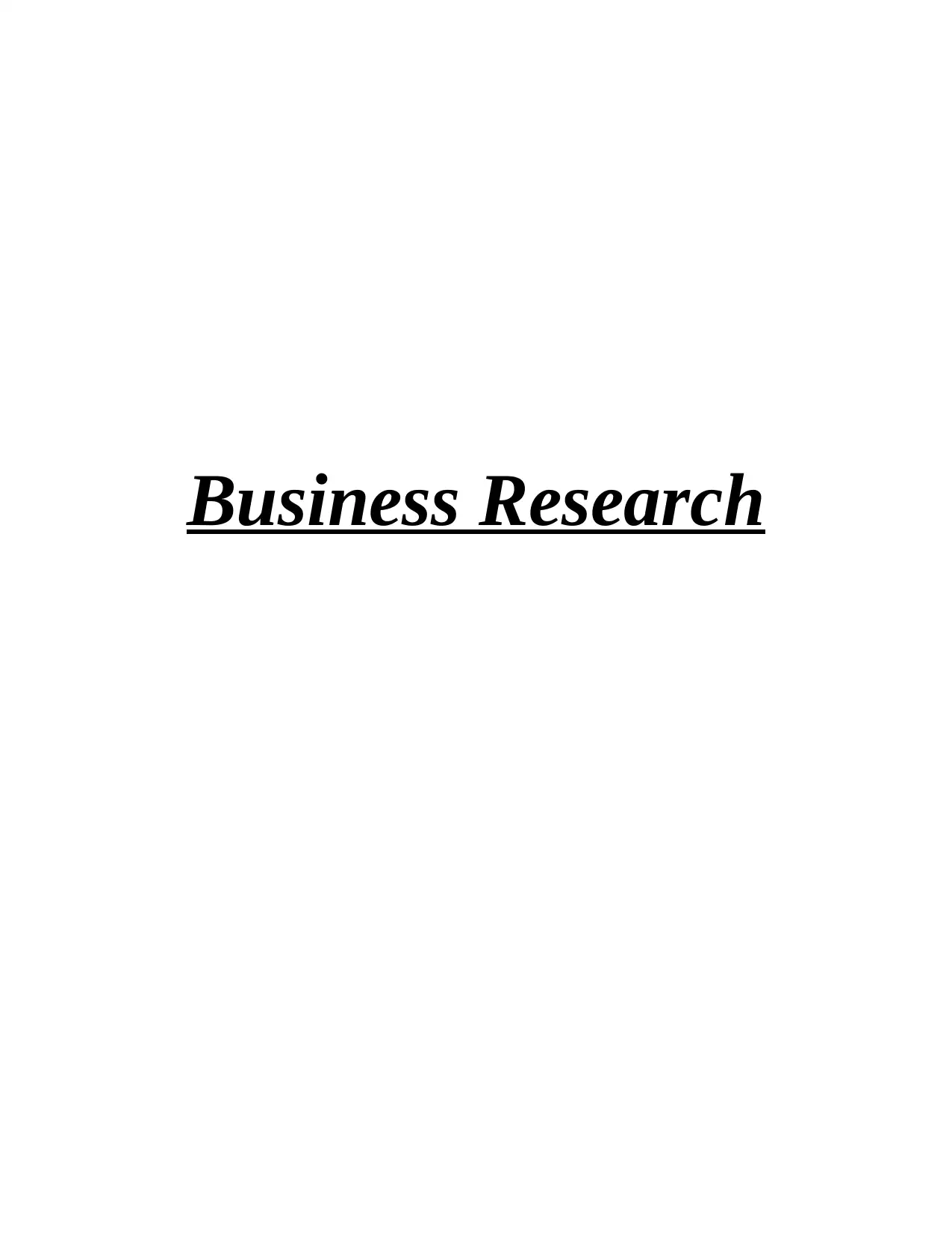
Business Research
Paraphrase This Document
Need a fresh take? Get an instant paraphrase of this document with our AI Paraphraser
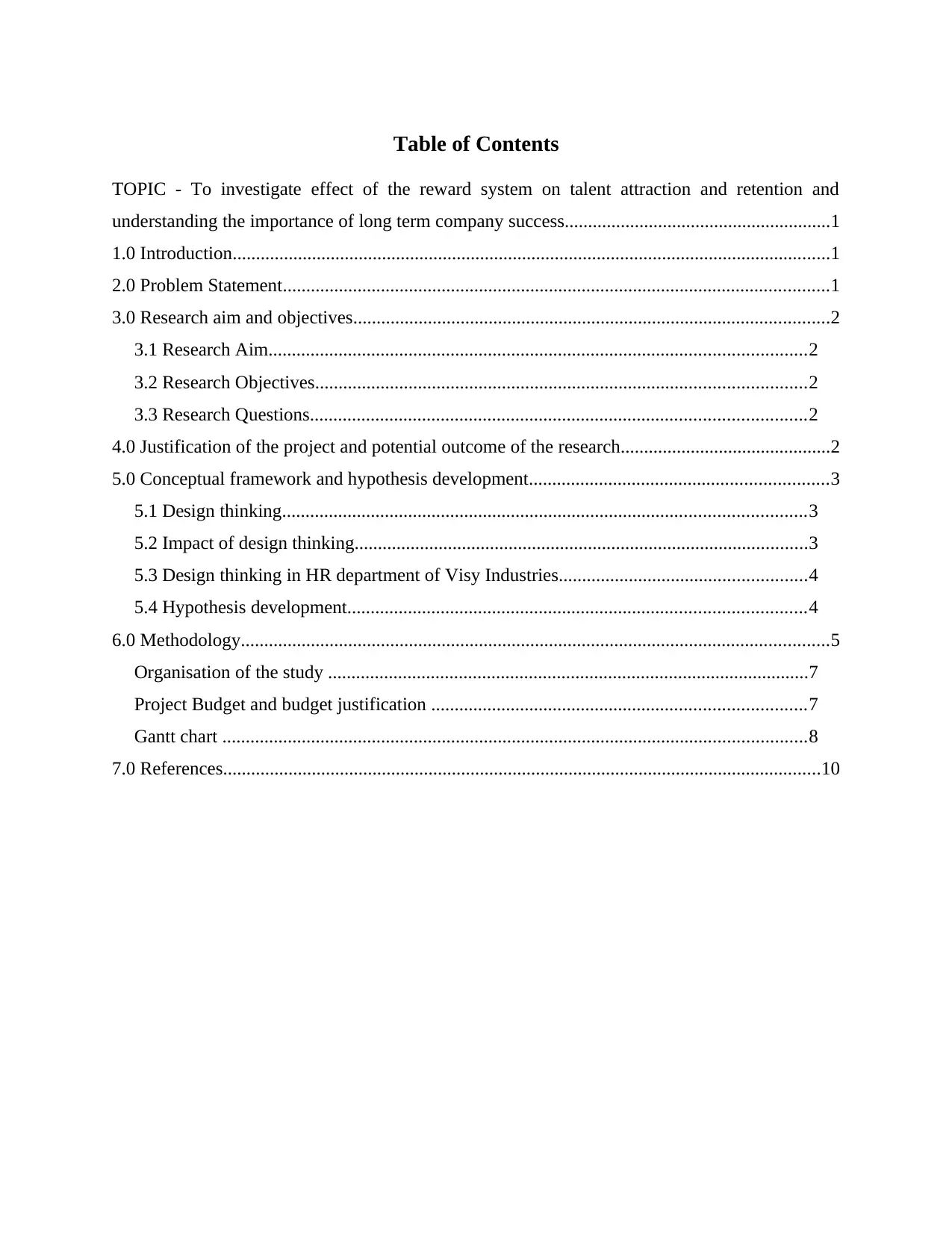
Table of Contents
TOPIC - To investigate effect of the reward system on talent attraction and retention and
understanding the importance of long term company success.........................................................1
1.0 Introduction................................................................................................................................1
2.0 Problem Statement.....................................................................................................................1
3.0 Research aim and objectives......................................................................................................2
3.1 Research Aim...................................................................................................................2
3.2 Research Objectives.........................................................................................................2
3.3 Research Questions..........................................................................................................2
4.0 Justification of the project and potential outcome of the research.............................................2
5.0 Conceptual framework and hypothesis development................................................................3
5.1 Design thinking................................................................................................................3
5.2 Impact of design thinking.................................................................................................3
5.3 Design thinking in HR department of Visy Industries.....................................................4
5.4 Hypothesis development..................................................................................................4
6.0 Methodology..............................................................................................................................5
Organisation of the study .......................................................................................................7
Project Budget and budget justification ................................................................................7
Gantt chart .............................................................................................................................8
7.0 References................................................................................................................................10
TOPIC - To investigate effect of the reward system on talent attraction and retention and
understanding the importance of long term company success.........................................................1
1.0 Introduction................................................................................................................................1
2.0 Problem Statement.....................................................................................................................1
3.0 Research aim and objectives......................................................................................................2
3.1 Research Aim...................................................................................................................2
3.2 Research Objectives.........................................................................................................2
3.3 Research Questions..........................................................................................................2
4.0 Justification of the project and potential outcome of the research.............................................2
5.0 Conceptual framework and hypothesis development................................................................3
5.1 Design thinking................................................................................................................3
5.2 Impact of design thinking.................................................................................................3
5.3 Design thinking in HR department of Visy Industries.....................................................4
5.4 Hypothesis development..................................................................................................4
6.0 Methodology..............................................................................................................................5
Organisation of the study .......................................................................................................7
Project Budget and budget justification ................................................................................7
Gantt chart .............................................................................................................................8
7.0 References................................................................................................................................10
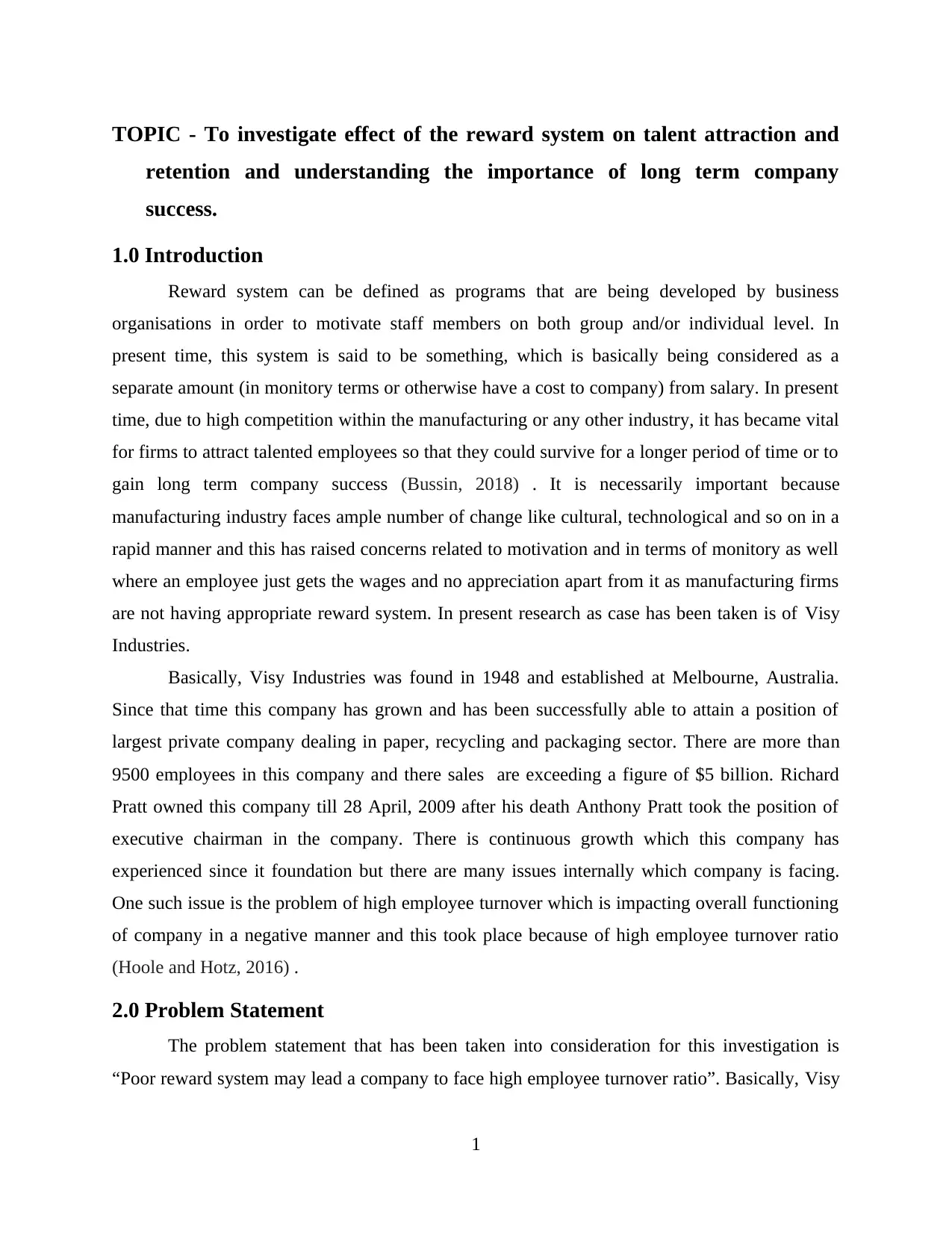
TOPIC - To investigate effect of the reward system on talent attraction and
retention and understanding the importance of long term company
success.
1.0 Introduction
Reward system can be defined as programs that are being developed by business
organisations in order to motivate staff members on both group and/or individual level. In
present time, this system is said to be something, which is basically being considered as a
separate amount (in monitory terms or otherwise have a cost to company) from salary. In present
time, due to high competition within the manufacturing or any other industry, it has became vital
for firms to attract talented employees so that they could survive for a longer period of time or to
gain long term company success (Bussin, 2018) . It is necessarily important because
manufacturing industry faces ample number of change like cultural, technological and so on in a
rapid manner and this has raised concerns related to motivation and in terms of monitory as well
where an employee just gets the wages and no appreciation apart from it as manufacturing firms
are not having appropriate reward system. In present research as case has been taken is of Visy
Industries.
Basically, Visy Industries was found in 1948 and established at Melbourne, Australia.
Since that time this company has grown and has been successfully able to attain a position of
largest private company dealing in paper, recycling and packaging sector. There are more than
9500 employees in this company and there sales are exceeding a figure of $5 billion. Richard
Pratt owned this company till 28 April, 2009 after his death Anthony Pratt took the position of
executive chairman in the company. There is continuous growth which this company has
experienced since it foundation but there are many issues internally which company is facing.
One such issue is the problem of high employee turnover which is impacting overall functioning
of company in a negative manner and this took place because of high employee turnover ratio
(Hoole and Hotz, 2016) .
2.0 Problem Statement
The problem statement that has been taken into consideration for this investigation is
“Poor reward system may lead a company to face high employee turnover ratio”. Basically, Visy
1
retention and understanding the importance of long term company
success.
1.0 Introduction
Reward system can be defined as programs that are being developed by business
organisations in order to motivate staff members on both group and/or individual level. In
present time, this system is said to be something, which is basically being considered as a
separate amount (in monitory terms or otherwise have a cost to company) from salary. In present
time, due to high competition within the manufacturing or any other industry, it has became vital
for firms to attract talented employees so that they could survive for a longer period of time or to
gain long term company success (Bussin, 2018) . It is necessarily important because
manufacturing industry faces ample number of change like cultural, technological and so on in a
rapid manner and this has raised concerns related to motivation and in terms of monitory as well
where an employee just gets the wages and no appreciation apart from it as manufacturing firms
are not having appropriate reward system. In present research as case has been taken is of Visy
Industries.
Basically, Visy Industries was found in 1948 and established at Melbourne, Australia.
Since that time this company has grown and has been successfully able to attain a position of
largest private company dealing in paper, recycling and packaging sector. There are more than
9500 employees in this company and there sales are exceeding a figure of $5 billion. Richard
Pratt owned this company till 28 April, 2009 after his death Anthony Pratt took the position of
executive chairman in the company. There is continuous growth which this company has
experienced since it foundation but there are many issues internally which company is facing.
One such issue is the problem of high employee turnover which is impacting overall functioning
of company in a negative manner and this took place because of high employee turnover ratio
(Hoole and Hotz, 2016) .
2.0 Problem Statement
The problem statement that has been taken into consideration for this investigation is
“Poor reward system may lead a company to face high employee turnover ratio”. Basically, Visy
1
⊘ This is a preview!⊘
Do you want full access?
Subscribe today to unlock all pages.

Trusted by 1+ million students worldwide
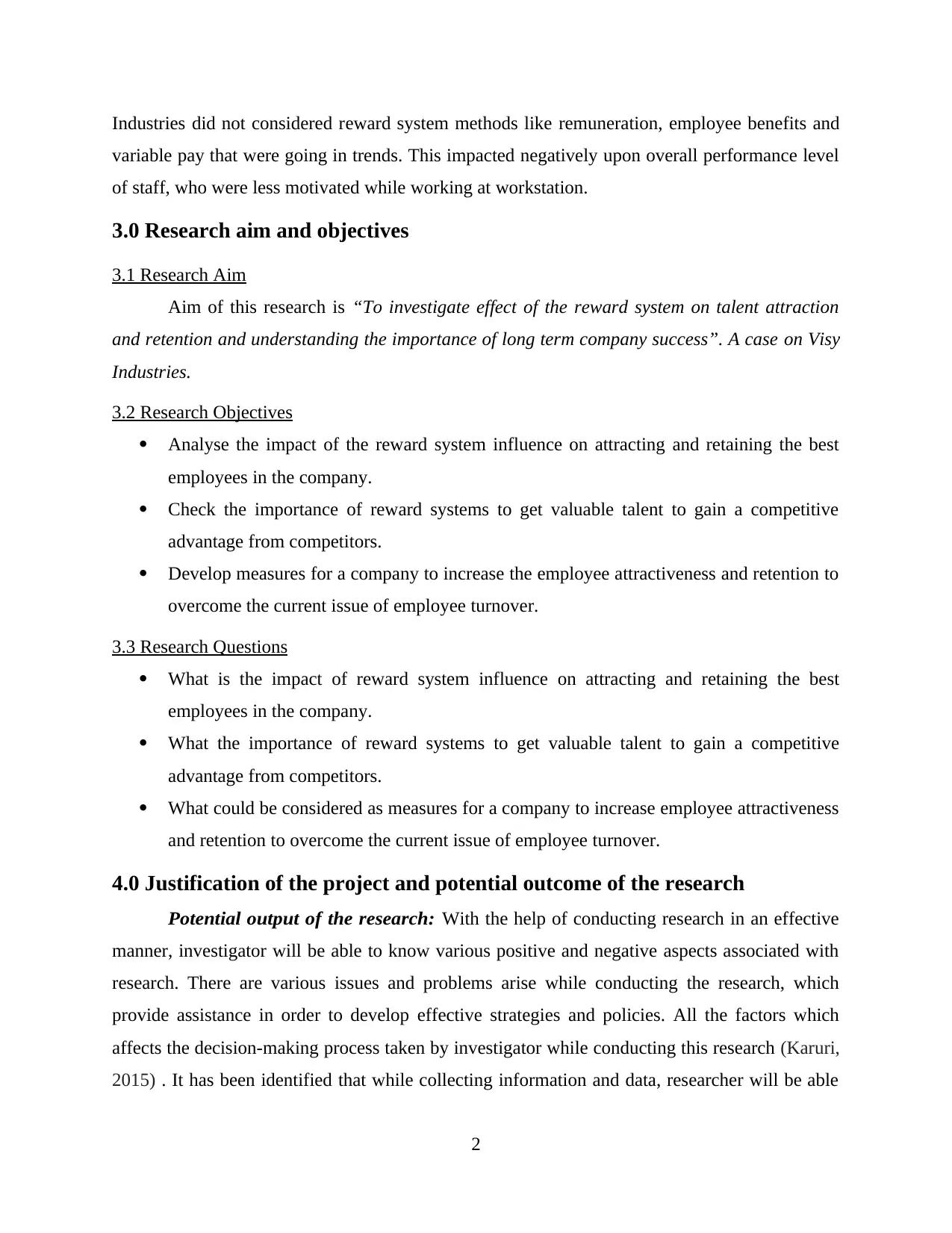
Industries did not considered reward system methods like remuneration, employee benefits and
variable pay that were going in trends. This impacted negatively upon overall performance level
of staff, who were less motivated while working at workstation.
3.0 Research aim and objectives
3.1 Research Aim
Aim of this research is “To investigate effect of the reward system on talent attraction
and retention and understanding the importance of long term company success”. A case on Visy
Industries.
3.2 Research Objectives
Analyse the impact of the reward system influence on attracting and retaining the best
employees in the company.
Check the importance of reward systems to get valuable talent to gain a competitive
advantage from competitors.
Develop measures for a company to increase the employee attractiveness and retention to
overcome the current issue of employee turnover.
3.3 Research Questions
What is the impact of reward system influence on attracting and retaining the best
employees in the company.
What the importance of reward systems to get valuable talent to gain a competitive
advantage from competitors.
What could be considered as measures for a company to increase employee attractiveness
and retention to overcome the current issue of employee turnover.
4.0 Justification of the project and potential outcome of the research
Potential output of the research: With the help of conducting research in an effective
manner, investigator will be able to know various positive and negative aspects associated with
research. There are various issues and problems arise while conducting the research, which
provide assistance in order to develop effective strategies and policies. All the factors which
affects the decision-making process taken by investigator while conducting this research (Karuri,
2015) . It has been identified that while collecting information and data, researcher will be able
2
variable pay that were going in trends. This impacted negatively upon overall performance level
of staff, who were less motivated while working at workstation.
3.0 Research aim and objectives
3.1 Research Aim
Aim of this research is “To investigate effect of the reward system on talent attraction
and retention and understanding the importance of long term company success”. A case on Visy
Industries.
3.2 Research Objectives
Analyse the impact of the reward system influence on attracting and retaining the best
employees in the company.
Check the importance of reward systems to get valuable talent to gain a competitive
advantage from competitors.
Develop measures for a company to increase the employee attractiveness and retention to
overcome the current issue of employee turnover.
3.3 Research Questions
What is the impact of reward system influence on attracting and retaining the best
employees in the company.
What the importance of reward systems to get valuable talent to gain a competitive
advantage from competitors.
What could be considered as measures for a company to increase employee attractiveness
and retention to overcome the current issue of employee turnover.
4.0 Justification of the project and potential outcome of the research
Potential output of the research: With the help of conducting research in an effective
manner, investigator will be able to know various positive and negative aspects associated with
research. There are various issues and problems arise while conducting the research, which
provide assistance in order to develop effective strategies and policies. All the factors which
affects the decision-making process taken by investigator while conducting this research (Karuri,
2015) . It has been identified that while collecting information and data, researcher will be able
2
Paraphrase This Document
Need a fresh take? Get an instant paraphrase of this document with our AI Paraphraser
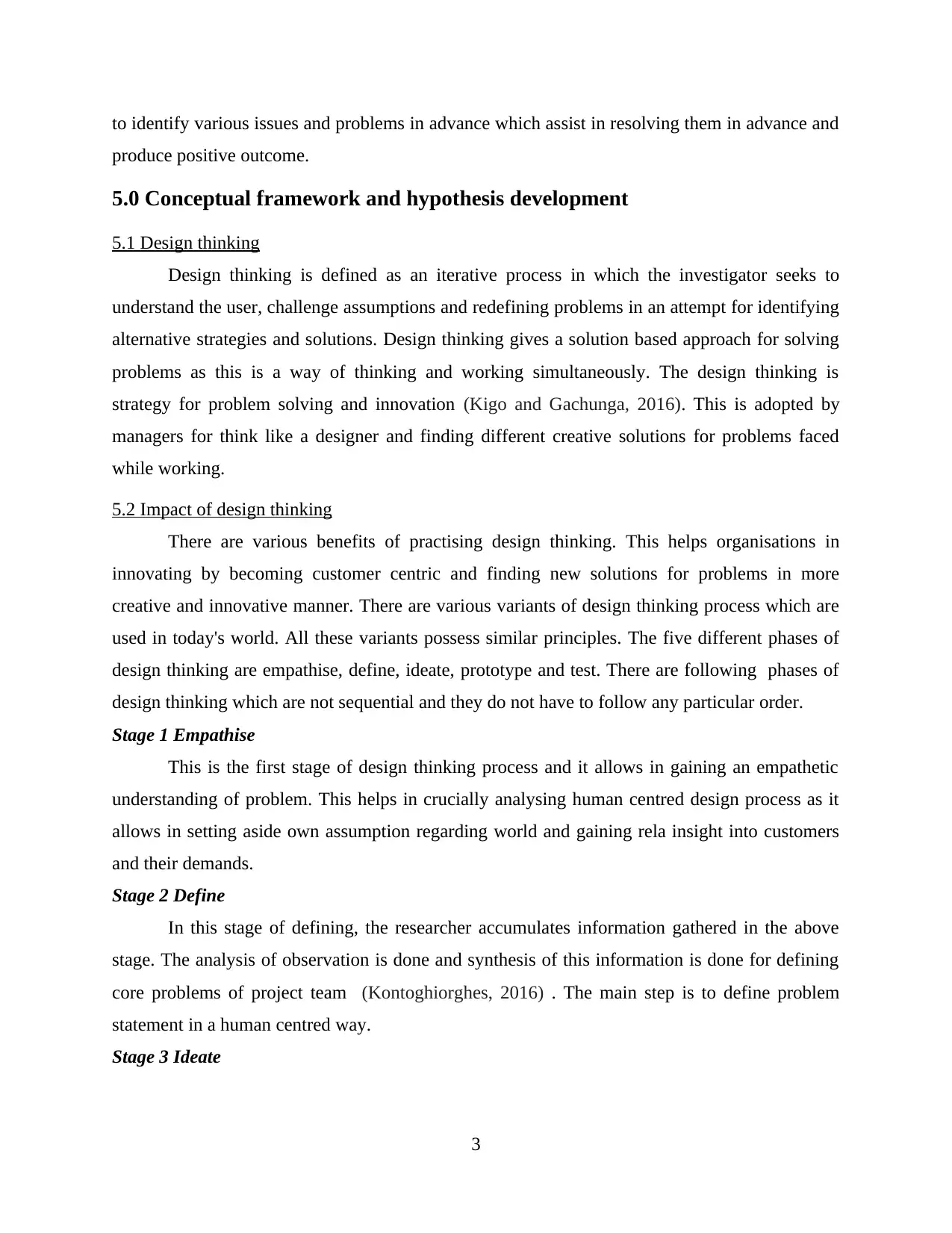
to identify various issues and problems in advance which assist in resolving them in advance and
produce positive outcome.
5.0 Conceptual framework and hypothesis development
5.1 Design thinking
Design thinking is defined as an iterative process in which the investigator seeks to
understand the user, challenge assumptions and redefining problems in an attempt for identifying
alternative strategies and solutions. Design thinking gives a solution based approach for solving
problems as this is a way of thinking and working simultaneously. The design thinking is
strategy for problem solving and innovation (Kigo and Gachunga, 2016). This is adopted by
managers for think like a designer and finding different creative solutions for problems faced
while working.
5.2 Impact of design thinking
There are various benefits of practising design thinking. This helps organisations in
innovating by becoming customer centric and finding new solutions for problems in more
creative and innovative manner. There are various variants of design thinking process which are
used in today's world. All these variants possess similar principles. The five different phases of
design thinking are empathise, define, ideate, prototype and test. There are following phases of
design thinking which are not sequential and they do not have to follow any particular order.
Stage 1 Empathise
This is the first stage of design thinking process and it allows in gaining an empathetic
understanding of problem. This helps in crucially analysing human centred design process as it
allows in setting aside own assumption regarding world and gaining rela insight into customers
and their demands.
Stage 2 Define
In this stage of defining, the researcher accumulates information gathered in the above
stage. The analysis of observation is done and synthesis of this information is done for defining
core problems of project team (Kontoghiorghes, 2016) . The main step is to define problem
statement in a human centred way.
Stage 3 Ideate
3
produce positive outcome.
5.0 Conceptual framework and hypothesis development
5.1 Design thinking
Design thinking is defined as an iterative process in which the investigator seeks to
understand the user, challenge assumptions and redefining problems in an attempt for identifying
alternative strategies and solutions. Design thinking gives a solution based approach for solving
problems as this is a way of thinking and working simultaneously. The design thinking is
strategy for problem solving and innovation (Kigo and Gachunga, 2016). This is adopted by
managers for think like a designer and finding different creative solutions for problems faced
while working.
5.2 Impact of design thinking
There are various benefits of practising design thinking. This helps organisations in
innovating by becoming customer centric and finding new solutions for problems in more
creative and innovative manner. There are various variants of design thinking process which are
used in today's world. All these variants possess similar principles. The five different phases of
design thinking are empathise, define, ideate, prototype and test. There are following phases of
design thinking which are not sequential and they do not have to follow any particular order.
Stage 1 Empathise
This is the first stage of design thinking process and it allows in gaining an empathetic
understanding of problem. This helps in crucially analysing human centred design process as it
allows in setting aside own assumption regarding world and gaining rela insight into customers
and their demands.
Stage 2 Define
In this stage of defining, the researcher accumulates information gathered in the above
stage. The analysis of observation is done and synthesis of this information is done for defining
core problems of project team (Kontoghiorghes, 2016) . The main step is to define problem
statement in a human centred way.
Stage 3 Ideate
3
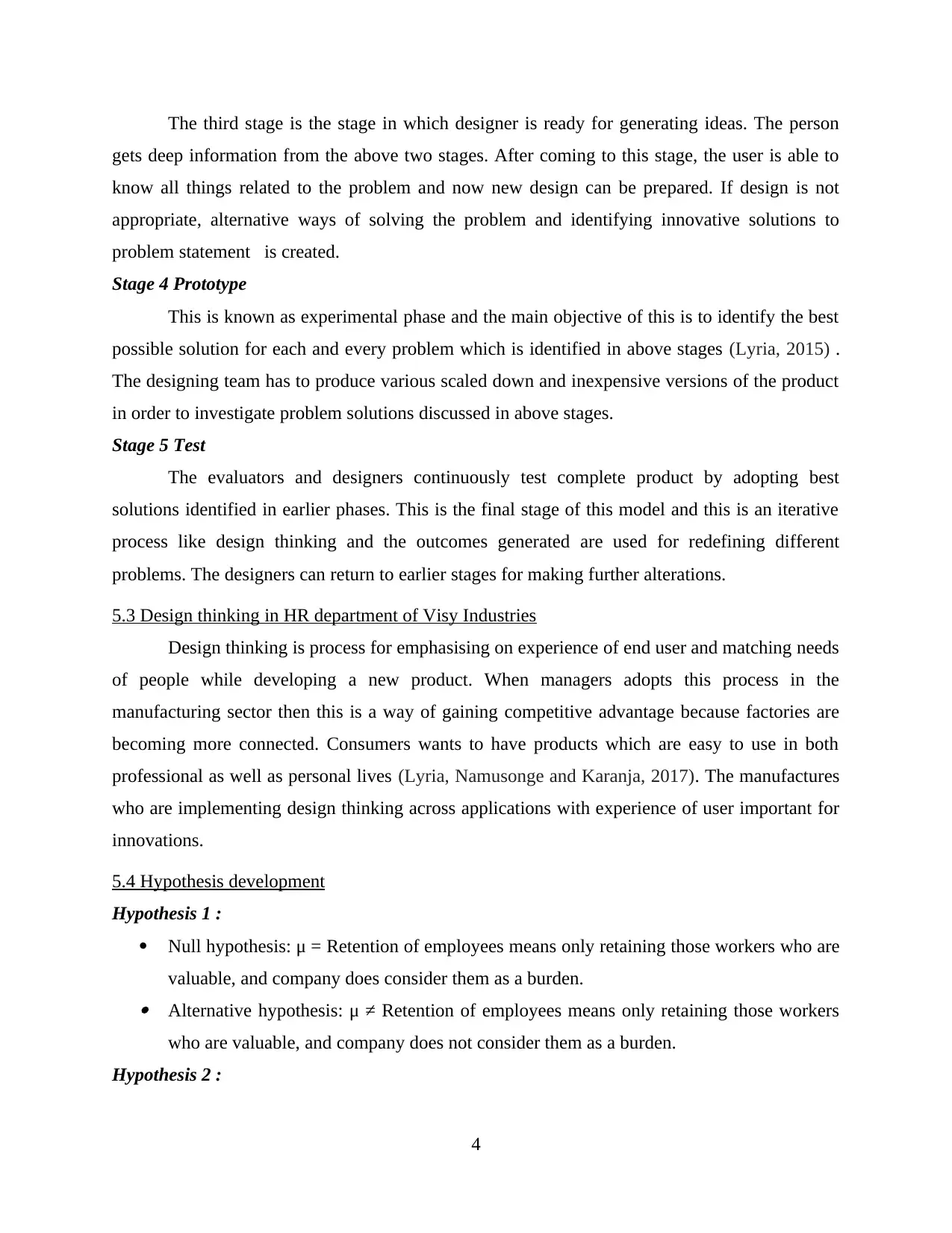
The third stage is the stage in which designer is ready for generating ideas. The person
gets deep information from the above two stages. After coming to this stage, the user is able to
know all things related to the problem and now new design can be prepared. If design is not
appropriate, alternative ways of solving the problem and identifying innovative solutions to
problem statement is created.
Stage 4 Prototype
This is known as experimental phase and the main objective of this is to identify the best
possible solution for each and every problem which is identified in above stages (Lyria, 2015) .
The designing team has to produce various scaled down and inexpensive versions of the product
in order to investigate problem solutions discussed in above stages.
Stage 5 Test
The evaluators and designers continuously test complete product by adopting best
solutions identified in earlier phases. This is the final stage of this model and this is an iterative
process like design thinking and the outcomes generated are used for redefining different
problems. The designers can return to earlier stages for making further alterations.
5.3 Design thinking in HR department of Visy Industries
Design thinking is process for emphasising on experience of end user and matching needs
of people while developing a new product. When managers adopts this process in the
manufacturing sector then this is a way of gaining competitive advantage because factories are
becoming more connected. Consumers wants to have products which are easy to use in both
professional as well as personal lives (Lyria, Namusonge and Karanja, 2017). The manufactures
who are implementing design thinking across applications with experience of user important for
innovations.
5.4 Hypothesis development
Hypothesis 1 :
Null hypothesis: μ = Retention of employees means only retaining those workers who are
valuable, and company does consider them as a burden. Alternative hypothesis: μ ≠ Retention of employees means only retaining those workers
who are valuable, and company does not consider them as a burden.
Hypothesis 2 :
4
gets deep information from the above two stages. After coming to this stage, the user is able to
know all things related to the problem and now new design can be prepared. If design is not
appropriate, alternative ways of solving the problem and identifying innovative solutions to
problem statement is created.
Stage 4 Prototype
This is known as experimental phase and the main objective of this is to identify the best
possible solution for each and every problem which is identified in above stages (Lyria, 2015) .
The designing team has to produce various scaled down and inexpensive versions of the product
in order to investigate problem solutions discussed in above stages.
Stage 5 Test
The evaluators and designers continuously test complete product by adopting best
solutions identified in earlier phases. This is the final stage of this model and this is an iterative
process like design thinking and the outcomes generated are used for redefining different
problems. The designers can return to earlier stages for making further alterations.
5.3 Design thinking in HR department of Visy Industries
Design thinking is process for emphasising on experience of end user and matching needs
of people while developing a new product. When managers adopts this process in the
manufacturing sector then this is a way of gaining competitive advantage because factories are
becoming more connected. Consumers wants to have products which are easy to use in both
professional as well as personal lives (Lyria, Namusonge and Karanja, 2017). The manufactures
who are implementing design thinking across applications with experience of user important for
innovations.
5.4 Hypothesis development
Hypothesis 1 :
Null hypothesis: μ = Retention of employees means only retaining those workers who are
valuable, and company does consider them as a burden. Alternative hypothesis: μ ≠ Retention of employees means only retaining those workers
who are valuable, and company does not consider them as a burden.
Hypothesis 2 :
4
⊘ This is a preview!⊘
Do you want full access?
Subscribe today to unlock all pages.

Trusted by 1+ million students worldwide
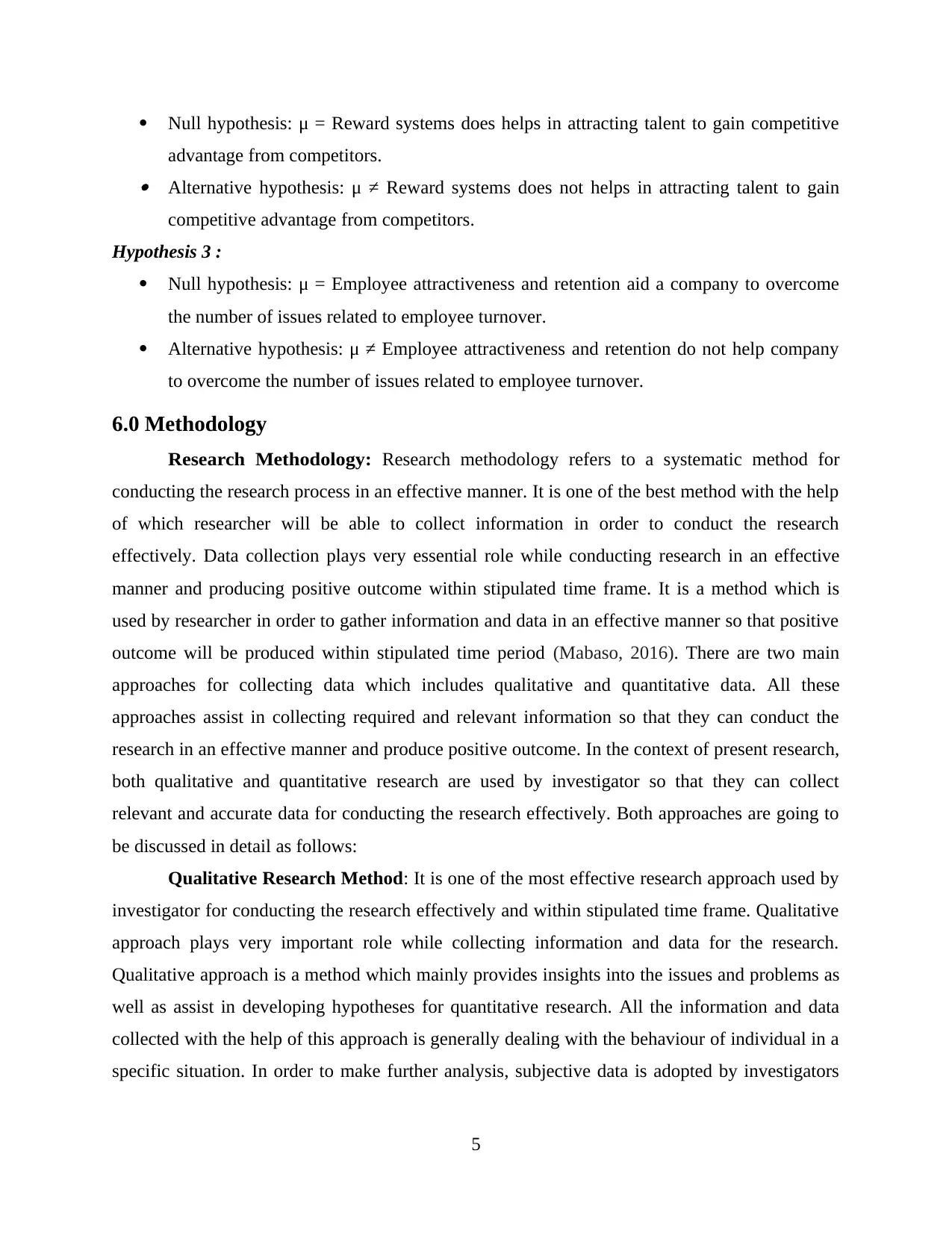
Null hypothesis: μ = Reward systems does helps in attracting talent to gain competitive
advantage from competitors. Alternative hypothesis: μ ≠ Reward systems does not helps in attracting talent to gain
competitive advantage from competitors.
Hypothesis 3 :
Null hypothesis: μ = Employee attractiveness and retention aid a company to overcome
the number of issues related to employee turnover.
Alternative hypothesis: μ ≠ Employee attractiveness and retention do not help company
to overcome the number of issues related to employee turnover.
6.0 Methodology
Research Methodology: Research methodology refers to a systematic method for
conducting the research process in an effective manner. It is one of the best method with the help
of which researcher will be able to collect information in order to conduct the research
effectively. Data collection plays very essential role while conducting research in an effective
manner and producing positive outcome within stipulated time frame. It is a method which is
used by researcher in order to gather information and data in an effective manner so that positive
outcome will be produced within stipulated time period (Mabaso, 2016). There are two main
approaches for collecting data which includes qualitative and quantitative data. All these
approaches assist in collecting required and relevant information so that they can conduct the
research in an effective manner and produce positive outcome. In the context of present research,
both qualitative and quantitative research are used by investigator so that they can collect
relevant and accurate data for conducting the research effectively. Both approaches are going to
be discussed in detail as follows:
Qualitative Research Method: It is one of the most effective research approach used by
investigator for conducting the research effectively and within stipulated time frame. Qualitative
approach plays very important role while collecting information and data for the research.
Qualitative approach is a method which mainly provides insights into the issues and problems as
well as assist in developing hypotheses for quantitative research. All the information and data
collected with the help of this approach is generally dealing with the behaviour of individual in a
specific situation. In order to make further analysis, subjective data is adopted by investigators
5
advantage from competitors. Alternative hypothesis: μ ≠ Reward systems does not helps in attracting talent to gain
competitive advantage from competitors.
Hypothesis 3 :
Null hypothesis: μ = Employee attractiveness and retention aid a company to overcome
the number of issues related to employee turnover.
Alternative hypothesis: μ ≠ Employee attractiveness and retention do not help company
to overcome the number of issues related to employee turnover.
6.0 Methodology
Research Methodology: Research methodology refers to a systematic method for
conducting the research process in an effective manner. It is one of the best method with the help
of which researcher will be able to collect information in order to conduct the research
effectively. Data collection plays very essential role while conducting research in an effective
manner and producing positive outcome within stipulated time frame. It is a method which is
used by researcher in order to gather information and data in an effective manner so that positive
outcome will be produced within stipulated time period (Mabaso, 2016). There are two main
approaches for collecting data which includes qualitative and quantitative data. All these
approaches assist in collecting required and relevant information so that they can conduct the
research in an effective manner and produce positive outcome. In the context of present research,
both qualitative and quantitative research are used by investigator so that they can collect
relevant and accurate data for conducting the research effectively. Both approaches are going to
be discussed in detail as follows:
Qualitative Research Method: It is one of the most effective research approach used by
investigator for conducting the research effectively and within stipulated time frame. Qualitative
approach plays very important role while collecting information and data for the research.
Qualitative approach is a method which mainly provides insights into the issues and problems as
well as assist in developing hypotheses for quantitative research. All the information and data
collected with the help of this approach is generally dealing with the behaviour of individual in a
specific situation. In order to make further analysis, subjective data is adopted by investigators
5
Paraphrase This Document
Need a fresh take? Get an instant paraphrase of this document with our AI Paraphraser
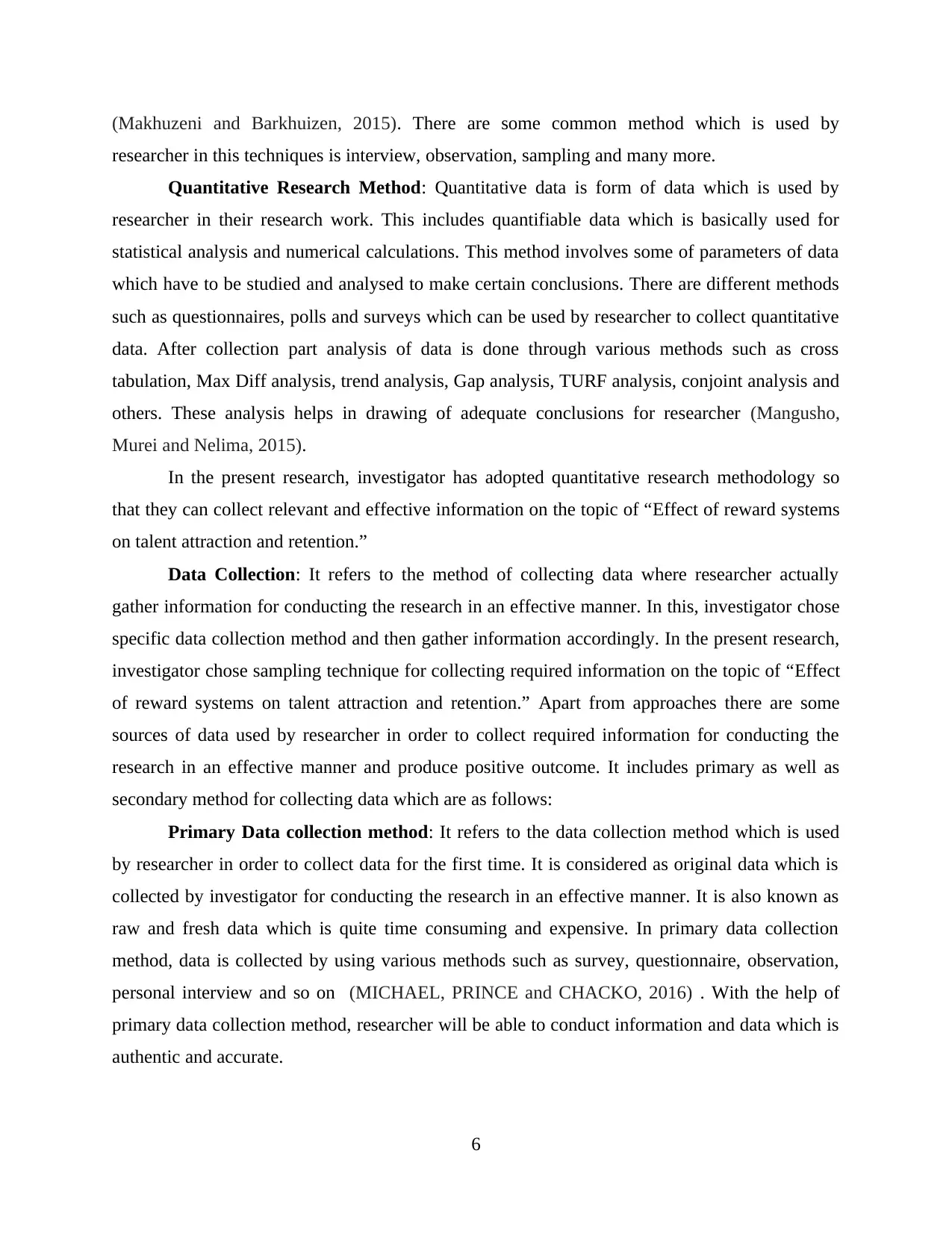
(Makhuzeni and Barkhuizen, 2015). There are some common method which is used by
researcher in this techniques is interview, observation, sampling and many more.
Quantitative Research Method: Quantitative data is form of data which is used by
researcher in their research work. This includes quantifiable data which is basically used for
statistical analysis and numerical calculations. This method involves some of parameters of data
which have to be studied and analysed to make certain conclusions. There are different methods
such as questionnaires, polls and surveys which can be used by researcher to collect quantitative
data. After collection part analysis of data is done through various methods such as cross
tabulation, Max Diff analysis, trend analysis, Gap analysis, TURF analysis, conjoint analysis and
others. These analysis helps in drawing of adequate conclusions for researcher (Mangusho,
Murei and Nelima, 2015).
In the present research, investigator has adopted quantitative research methodology so
that they can collect relevant and effective information on the topic of “Effect of reward systems
on talent attraction and retention.”
Data Collection: It refers to the method of collecting data where researcher actually
gather information for conducting the research in an effective manner. In this, investigator chose
specific data collection method and then gather information accordingly. In the present research,
investigator chose sampling technique for collecting required information on the topic of “Effect
of reward systems on talent attraction and retention.” Apart from approaches there are some
sources of data used by researcher in order to collect required information for conducting the
research in an effective manner and produce positive outcome. It includes primary as well as
secondary method for collecting data which are as follows:
Primary Data collection method: It refers to the data collection method which is used
by researcher in order to collect data for the first time. It is considered as original data which is
collected by investigator for conducting the research in an effective manner. It is also known as
raw and fresh data which is quite time consuming and expensive. In primary data collection
method, data is collected by using various methods such as survey, questionnaire, observation,
personal interview and so on (MICHAEL, PRINCE and CHACKO, 2016) . With the help of
primary data collection method, researcher will be able to conduct information and data which is
authentic and accurate.
6
researcher in this techniques is interview, observation, sampling and many more.
Quantitative Research Method: Quantitative data is form of data which is used by
researcher in their research work. This includes quantifiable data which is basically used for
statistical analysis and numerical calculations. This method involves some of parameters of data
which have to be studied and analysed to make certain conclusions. There are different methods
such as questionnaires, polls and surveys which can be used by researcher to collect quantitative
data. After collection part analysis of data is done through various methods such as cross
tabulation, Max Diff analysis, trend analysis, Gap analysis, TURF analysis, conjoint analysis and
others. These analysis helps in drawing of adequate conclusions for researcher (Mangusho,
Murei and Nelima, 2015).
In the present research, investigator has adopted quantitative research methodology so
that they can collect relevant and effective information on the topic of “Effect of reward systems
on talent attraction and retention.”
Data Collection: It refers to the method of collecting data where researcher actually
gather information for conducting the research in an effective manner. In this, investigator chose
specific data collection method and then gather information accordingly. In the present research,
investigator chose sampling technique for collecting required information on the topic of “Effect
of reward systems on talent attraction and retention.” Apart from approaches there are some
sources of data used by researcher in order to collect required information for conducting the
research in an effective manner and produce positive outcome. It includes primary as well as
secondary method for collecting data which are as follows:
Primary Data collection method: It refers to the data collection method which is used
by researcher in order to collect data for the first time. It is considered as original data which is
collected by investigator for conducting the research in an effective manner. It is also known as
raw and fresh data which is quite time consuming and expensive. In primary data collection
method, data is collected by using various methods such as survey, questionnaire, observation,
personal interview and so on (MICHAEL, PRINCE and CHACKO, 2016) . With the help of
primary data collection method, researcher will be able to conduct information and data which is
authentic and accurate.
6
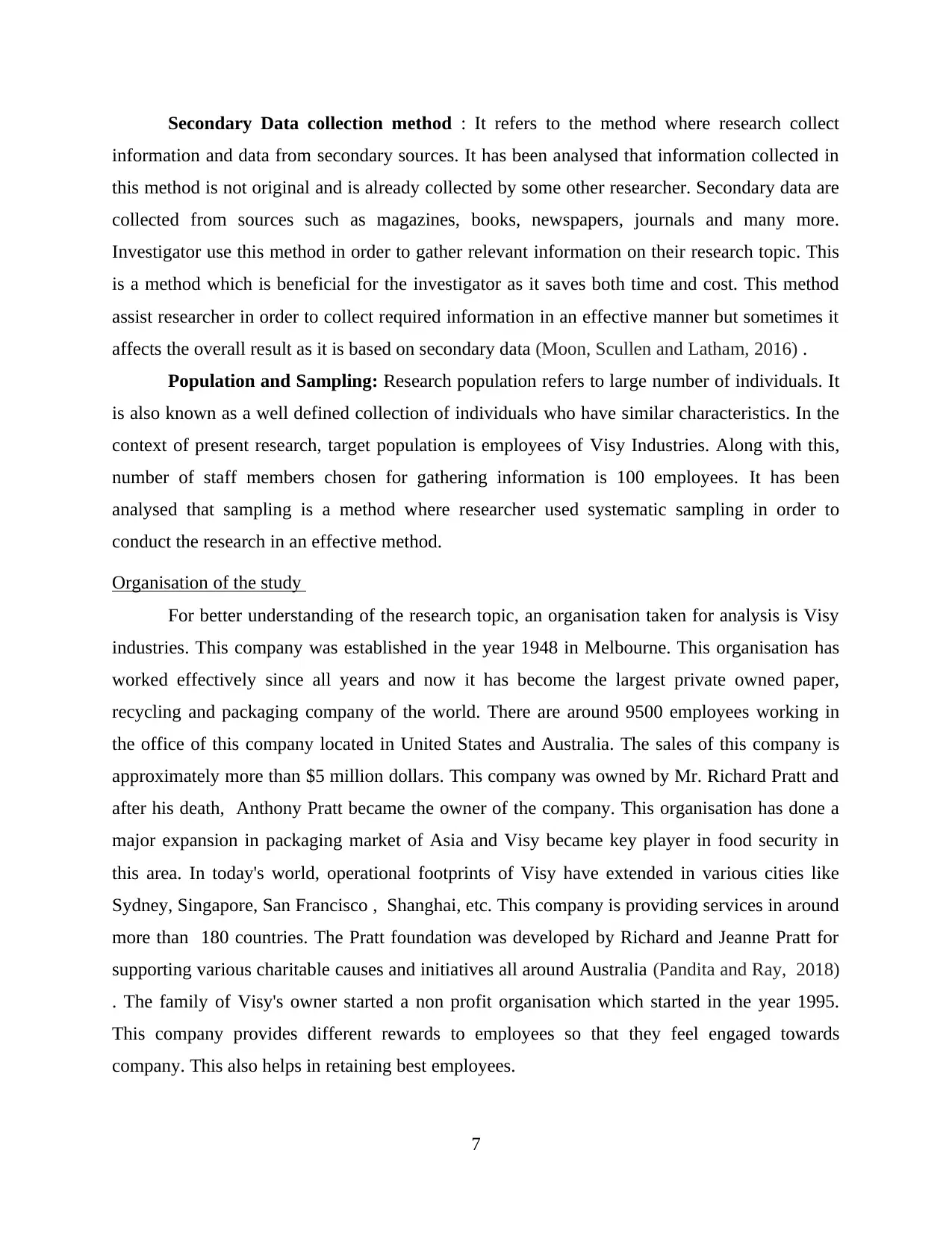
Secondary Data collection method : It refers to the method where research collect
information and data from secondary sources. It has been analysed that information collected in
this method is not original and is already collected by some other researcher. Secondary data are
collected from sources such as magazines, books, newspapers, journals and many more.
Investigator use this method in order to gather relevant information on their research topic. This
is a method which is beneficial for the investigator as it saves both time and cost. This method
assist researcher in order to collect required information in an effective manner but sometimes it
affects the overall result as it is based on secondary data (Moon, Scullen and Latham, 2016) .
Population and Sampling: Research population refers to large number of individuals. It
is also known as a well defined collection of individuals who have similar characteristics. In the
context of present research, target population is employees of Visy Industries. Along with this,
number of staff members chosen for gathering information is 100 employees. It has been
analysed that sampling is a method where researcher used systematic sampling in order to
conduct the research in an effective method.
Organisation of the study
For better understanding of the research topic, an organisation taken for analysis is Visy
industries. This company was established in the year 1948 in Melbourne. This organisation has
worked effectively since all years and now it has become the largest private owned paper,
recycling and packaging company of the world. There are around 9500 employees working in
the office of this company located in United States and Australia. The sales of this company is
approximately more than $5 million dollars. This company was owned by Mr. Richard Pratt and
after his death, Anthony Pratt became the owner of the company. This organisation has done a
major expansion in packaging market of Asia and Visy became key player in food security in
this area. In today's world, operational footprints of Visy have extended in various cities like
Sydney, Singapore, San Francisco , Shanghai, etc. This company is providing services in around
more than 180 countries. The Pratt foundation was developed by Richard and Jeanne Pratt for
supporting various charitable causes and initiatives all around Australia (Pandita and Ray, 2018)
. The family of Visy's owner started a non profit organisation which started in the year 1995.
This company provides different rewards to employees so that they feel engaged towards
company. This also helps in retaining best employees.
7
information and data from secondary sources. It has been analysed that information collected in
this method is not original and is already collected by some other researcher. Secondary data are
collected from sources such as magazines, books, newspapers, journals and many more.
Investigator use this method in order to gather relevant information on their research topic. This
is a method which is beneficial for the investigator as it saves both time and cost. This method
assist researcher in order to collect required information in an effective manner but sometimes it
affects the overall result as it is based on secondary data (Moon, Scullen and Latham, 2016) .
Population and Sampling: Research population refers to large number of individuals. It
is also known as a well defined collection of individuals who have similar characteristics. In the
context of present research, target population is employees of Visy Industries. Along with this,
number of staff members chosen for gathering information is 100 employees. It has been
analysed that sampling is a method where researcher used systematic sampling in order to
conduct the research in an effective method.
Organisation of the study
For better understanding of the research topic, an organisation taken for analysis is Visy
industries. This company was established in the year 1948 in Melbourne. This organisation has
worked effectively since all years and now it has become the largest private owned paper,
recycling and packaging company of the world. There are around 9500 employees working in
the office of this company located in United States and Australia. The sales of this company is
approximately more than $5 million dollars. This company was owned by Mr. Richard Pratt and
after his death, Anthony Pratt became the owner of the company. This organisation has done a
major expansion in packaging market of Asia and Visy became key player in food security in
this area. In today's world, operational footprints of Visy have extended in various cities like
Sydney, Singapore, San Francisco , Shanghai, etc. This company is providing services in around
more than 180 countries. The Pratt foundation was developed by Richard and Jeanne Pratt for
supporting various charitable causes and initiatives all around Australia (Pandita and Ray, 2018)
. The family of Visy's owner started a non profit organisation which started in the year 1995.
This company provides different rewards to employees so that they feel engaged towards
company. This also helps in retaining best employees.
7
⊘ This is a preview!⊘
Do you want full access?
Subscribe today to unlock all pages.

Trusted by 1+ million students worldwide
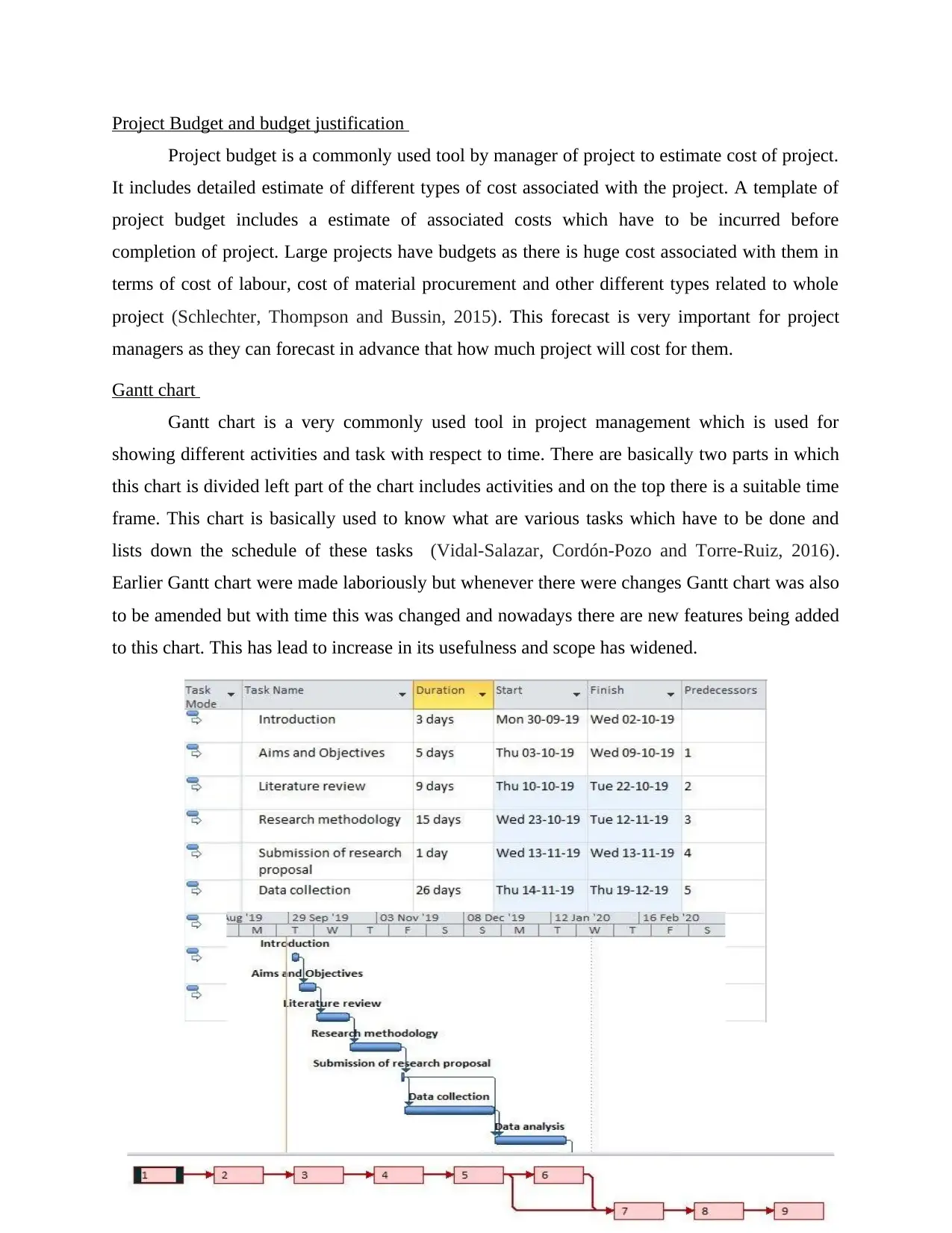
Project Budget and budget justification
Project budget is a commonly used tool by manager of project to estimate cost of project.
It includes detailed estimate of different types of cost associated with the project. A template of
project budget includes a estimate of associated costs which have to be incurred before
completion of project. Large projects have budgets as there is huge cost associated with them in
terms of cost of labour, cost of material procurement and other different types related to whole
project (Schlechter, Thompson and Bussin, 2015). This forecast is very important for project
managers as they can forecast in advance that how much project will cost for them.
Gantt chart
Gantt chart is a very commonly used tool in project management which is used for
showing different activities and task with respect to time. There are basically two parts in which
this chart is divided left part of the chart includes activities and on the top there is a suitable time
frame. This chart is basically used to know what are various tasks which have to be done and
lists down the schedule of these tasks (Vidal-Salazar, Cordón-Pozo and Torre-Ruiz, 2016).
Earlier Gantt chart were made laboriously but whenever there were changes Gantt chart was also
to be amended but with time this was changed and nowadays there are new features being added
to this chart. This has lead to increase in its usefulness and scope has widened.
8
Project budget is a commonly used tool by manager of project to estimate cost of project.
It includes detailed estimate of different types of cost associated with the project. A template of
project budget includes a estimate of associated costs which have to be incurred before
completion of project. Large projects have budgets as there is huge cost associated with them in
terms of cost of labour, cost of material procurement and other different types related to whole
project (Schlechter, Thompson and Bussin, 2015). This forecast is very important for project
managers as they can forecast in advance that how much project will cost for them.
Gantt chart
Gantt chart is a very commonly used tool in project management which is used for
showing different activities and task with respect to time. There are basically two parts in which
this chart is divided left part of the chart includes activities and on the top there is a suitable time
frame. This chart is basically used to know what are various tasks which have to be done and
lists down the schedule of these tasks (Vidal-Salazar, Cordón-Pozo and Torre-Ruiz, 2016).
Earlier Gantt chart were made laboriously but whenever there were changes Gantt chart was also
to be amended but with time this was changed and nowadays there are new features being added
to this chart. This has lead to increase in its usefulness and scope has widened.
8
Paraphrase This Document
Need a fresh take? Get an instant paraphrase of this document with our AI Paraphraser
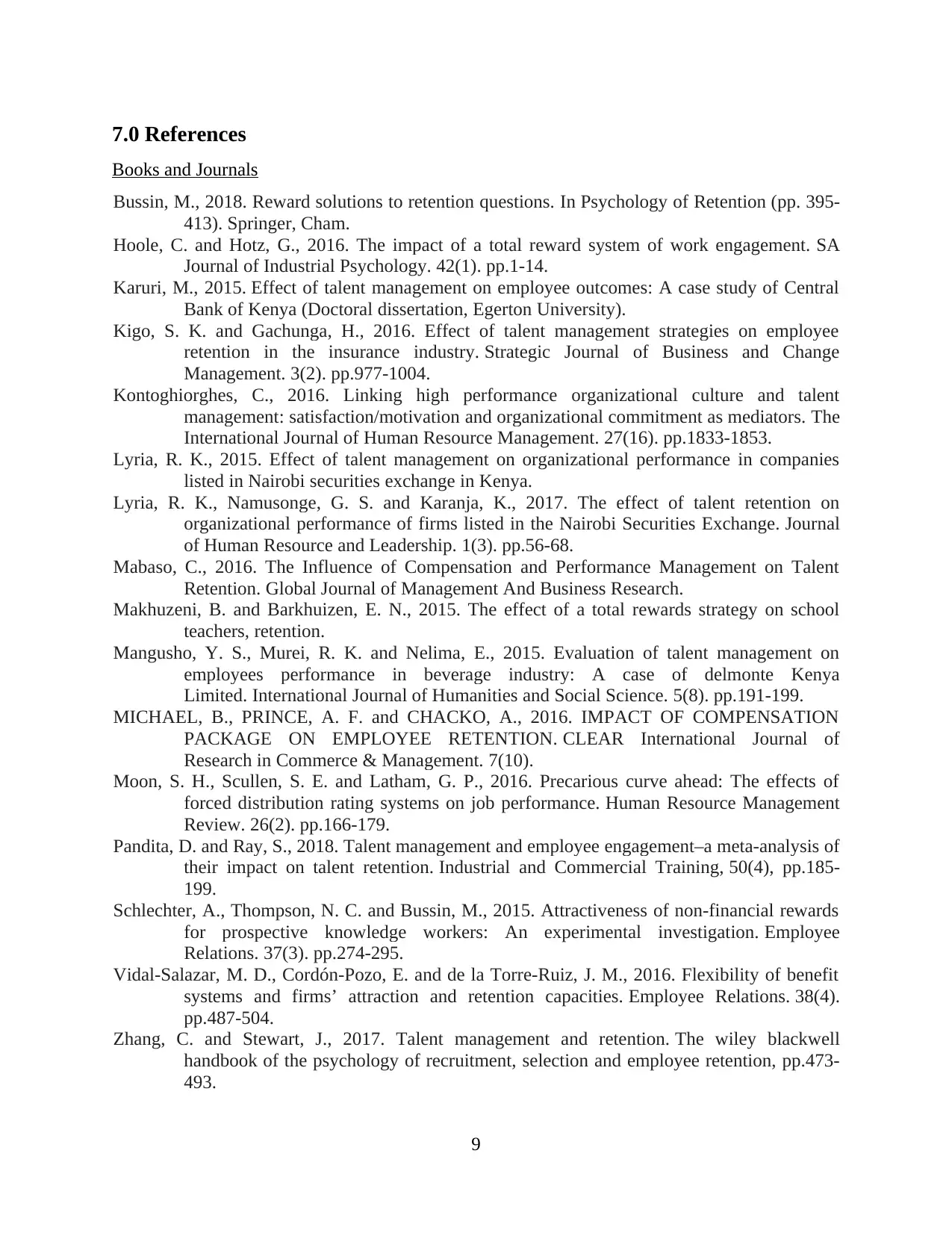
7.0 References
Books and Journals
Bussin, M., 2018. Reward solutions to retention questions. In Psychology of Retention (pp. 395-
413). Springer, Cham.
Hoole, C. and Hotz, G., 2016. The impact of a total reward system of work engagement. SA
Journal of Industrial Psychology. 42(1). pp.1-14.
Karuri, M., 2015. Effect of talent management on employee outcomes: A case study of Central
Bank of Kenya (Doctoral dissertation, Egerton University).
Kigo, S. K. and Gachunga, H., 2016. Effect of talent management strategies on employee
retention in the insurance industry. Strategic Journal of Business and Change
Management. 3(2). pp.977-1004.
Kontoghiorghes, C., 2016. Linking high performance organizational culture and talent
management: satisfaction/motivation and organizational commitment as mediators. The
International Journal of Human Resource Management. 27(16). pp.1833-1853.
Lyria, R. K., 2015. Effect of talent management on organizational performance in companies
listed in Nairobi securities exchange in Kenya.
Lyria, R. K., Namusonge, G. S. and Karanja, K., 2017. The effect of talent retention on
organizational performance of firms listed in the Nairobi Securities Exchange. Journal
of Human Resource and Leadership. 1(3). pp.56-68.
Mabaso, C., 2016. The Influence of Compensation and Performance Management on Talent
Retention. Global Journal of Management And Business Research.
Makhuzeni, B. and Barkhuizen, E. N., 2015. The effect of a total rewards strategy on school
teachers, retention.
Mangusho, Y. S., Murei, R. K. and Nelima, E., 2015. Evaluation of talent management on
employees performance in beverage industry: A case of delmonte Kenya
Limited. International Journal of Humanities and Social Science. 5(8). pp.191-199.
MICHAEL, B., PRINCE, A. F. and CHACKO, A., 2016. IMPACT OF COMPENSATION
PACKAGE ON EMPLOYEE RETENTION. CLEAR International Journal of
Research in Commerce & Management. 7(10).
Moon, S. H., Scullen, S. E. and Latham, G. P., 2016. Precarious curve ahead: The effects of
forced distribution rating systems on job performance. Human Resource Management
Review. 26(2). pp.166-179.
Pandita, D. and Ray, S., 2018. Talent management and employee engagement–a meta-analysis of
their impact on talent retention. Industrial and Commercial Training, 50(4), pp.185-
199.
Schlechter, A., Thompson, N. C. and Bussin, M., 2015. Attractiveness of non-financial rewards
for prospective knowledge workers: An experimental investigation. Employee
Relations. 37(3). pp.274-295.
Vidal-Salazar, M. D., Cordón-Pozo, E. and de la Torre-Ruiz, J. M., 2016. Flexibility of benefit
systems and firms’ attraction and retention capacities. Employee Relations. 38(4).
pp.487-504.
Zhang, C. and Stewart, J., 2017. Talent management and retention. The wiley blackwell
handbook of the psychology of recruitment, selection and employee retention, pp.473-
493.
9
Books and Journals
Bussin, M., 2018. Reward solutions to retention questions. In Psychology of Retention (pp. 395-
413). Springer, Cham.
Hoole, C. and Hotz, G., 2016. The impact of a total reward system of work engagement. SA
Journal of Industrial Psychology. 42(1). pp.1-14.
Karuri, M., 2015. Effect of talent management on employee outcomes: A case study of Central
Bank of Kenya (Doctoral dissertation, Egerton University).
Kigo, S. K. and Gachunga, H., 2016. Effect of talent management strategies on employee
retention in the insurance industry. Strategic Journal of Business and Change
Management. 3(2). pp.977-1004.
Kontoghiorghes, C., 2016. Linking high performance organizational culture and talent
management: satisfaction/motivation and organizational commitment as mediators. The
International Journal of Human Resource Management. 27(16). pp.1833-1853.
Lyria, R. K., 2015. Effect of talent management on organizational performance in companies
listed in Nairobi securities exchange in Kenya.
Lyria, R. K., Namusonge, G. S. and Karanja, K., 2017. The effect of talent retention on
organizational performance of firms listed in the Nairobi Securities Exchange. Journal
of Human Resource and Leadership. 1(3). pp.56-68.
Mabaso, C., 2016. The Influence of Compensation and Performance Management on Talent
Retention. Global Journal of Management And Business Research.
Makhuzeni, B. and Barkhuizen, E. N., 2015. The effect of a total rewards strategy on school
teachers, retention.
Mangusho, Y. S., Murei, R. K. and Nelima, E., 2015. Evaluation of talent management on
employees performance in beverage industry: A case of delmonte Kenya
Limited. International Journal of Humanities and Social Science. 5(8). pp.191-199.
MICHAEL, B., PRINCE, A. F. and CHACKO, A., 2016. IMPACT OF COMPENSATION
PACKAGE ON EMPLOYEE RETENTION. CLEAR International Journal of
Research in Commerce & Management. 7(10).
Moon, S. H., Scullen, S. E. and Latham, G. P., 2016. Precarious curve ahead: The effects of
forced distribution rating systems on job performance. Human Resource Management
Review. 26(2). pp.166-179.
Pandita, D. and Ray, S., 2018. Talent management and employee engagement–a meta-analysis of
their impact on talent retention. Industrial and Commercial Training, 50(4), pp.185-
199.
Schlechter, A., Thompson, N. C. and Bussin, M., 2015. Attractiveness of non-financial rewards
for prospective knowledge workers: An experimental investigation. Employee
Relations. 37(3). pp.274-295.
Vidal-Salazar, M. D., Cordón-Pozo, E. and de la Torre-Ruiz, J. M., 2016. Flexibility of benefit
systems and firms’ attraction and retention capacities. Employee Relations. 38(4).
pp.487-504.
Zhang, C. and Stewart, J., 2017. Talent management and retention. The wiley blackwell
handbook of the psychology of recruitment, selection and employee retention, pp.473-
493.
9
1 out of 11
Related Documents
Your All-in-One AI-Powered Toolkit for Academic Success.
+13062052269
info@desklib.com
Available 24*7 on WhatsApp / Email
![[object Object]](/_next/static/media/star-bottom.7253800d.svg)
Unlock your academic potential
Copyright © 2020–2025 A2Z Services. All Rights Reserved. Developed and managed by ZUCOL.




